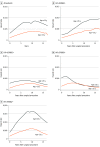Age-Related Incidence and Peak Occurrence of Contralateral Breast Cancer
- PMID: 38100108
- PMCID: PMC10724757
- DOI: 10.1001/jamanetworkopen.2023.47511
Age-Related Incidence and Peak Occurrence of Contralateral Breast Cancer
Abstract
Importance: Young patients with breast cancer have higher risk for developing contralateral breast cancer (CBC) and have epidemiologic characteristics different from those of older patients.
Objective: To examine the incidence and peak occurrence of CBC according to age at primary breast cancer (PBC) surgery.
Design, setting, and participants: This cohort study included patients who were diagnosed with and underwent surgery for unilateral nonmetastatic breast cancer at Asan Medical Center, Korea, between January 1, 1999, and December 31, 2013, with follow-up through December 31, 2018. Data were analyzed from December 1, 2021, through April 30, 2023. Patients were divided into 2 groups according to their age at surgery for PBC: younger (≤35 years) vs older (>35 years).
Main outcomes and measures: The main outcomes were cumulative incidence and hazard rate of CBC in the entire study population and in subgroups divided by cancer subtype, categorized according to hormone receptor (HR) and ERBB2 status.
Results: A total of 16 251 female patients with stage 0 to III breast cancer were analyzed; all patients were Korean. The mean (SD) age was 48.61 (10.06) years; 1318 patients (8.11%) were in the younger group, and 14 933 (91.89%) were in the older group. Median follow-up was 107 months (IQR, 79-145 months). Compared with the older group, the younger group had significantly higher incidence of CBC (10-year cumulative incidence, 7.1% vs 2.9%; P < .001) and higher risk (hazard ratio, 2.10; 95% CI, 1.62-2.74) of developing CBC. The hazard rate, which indicates risk for developing CBC at a certain time frame, differed according to the subtype of primary cancer. In patients with the HR+/ERBB2- subtype, the risk increased continuously in both age groups. In patients with the triple negative subtype, the risk increased until approximately 10 years and then decreased in both age groups. Meanwhile, in the HR-/ERBB2+ subtype, risk peaked earlier, especially in the younger group (1.7 years since first surgery in the younger group and 4.8 years in the older group).
Conclusions and relevance: In this cohort study, patients aged 35 years or younger with breast cancer had a higher risk of developing CBC than older patients. Moreover, young patients with the HR-/ERBB2+ subtype tended to have a shorter interval for developing CBC. These findings might be useful in guiding treatment decisions, such as contralateral prophylactic mastectomy.
Conflict of interest statement
Figures



Similar articles
-
Survival After Development of Contralateral Breast Cancer in Korean Patients With Breast Cancer.JAMA Netw Open. 2023 Sep 5;6(9):e2333557. doi: 10.1001/jamanetworkopen.2023.33557. JAMA Netw Open. 2023. PMID: 37707815 Free PMC article.
-
Locoregional Recurrence Patterns in Patients With Different Molecular Subtypes of Breast Cancer.JAMA Surg. 2023 Aug 1;158(8):841-852. doi: 10.1001/jamasurg.2023.2150. JAMA Surg. 2023. PMID: 37342035 Free PMC article.
-
Age-related risk factors associated with primary contralateral breast cancer among younger women versus older women.Breast Cancer Res Treat. 2019 Feb;173(3):657-665. doi: 10.1007/s10549-018-5031-4. Epub 2018 Oct 30. Breast Cancer Res Treat. 2019. PMID: 30377870
-
Breast cancer treatment in mutation carriers: surgical treatment.Minerva Ginecol. 2016 Oct;68(5):548-56. Epub 2016 Jan 28. Minerva Ginecol. 2016. PMID: 26822896 Review.
-
[Contralateral breast cancer: metastasis or second primary cancer?].Bull Cancer. 1996 Oct;83(10):870-6. Bull Cancer. 1996. PMID: 8952638 Review. French.
Cited by
-
Risk of second primary cancer in young breast cancer survivors: an important yet overlooked issue.Ther Adv Med Oncol. 2025 Feb 24;17:17588359251321904. doi: 10.1177/17588359251321904. eCollection 2025. Ther Adv Med Oncol. 2025. PMID: 40012707 Free PMC article. Review.
References
-
- Reiner AS, John EM, Brooks JD, et al. . Risk of asynchronous contralateral breast cancer in noncarriers of BRCA1 and BRCA2 mutations with a family history of breast cancer: a report from the Women’s Environmental Cancer and Radiation Epidemiology Study. J Clin Oncol. 2013;31(4):433-439. doi:10.1200/JCO.2012.43.2013 - DOI - PMC - PubMed
Publication types
MeSH terms
LinkOut - more resources
Full Text Sources
Medical
Research Materials
Miscellaneous

